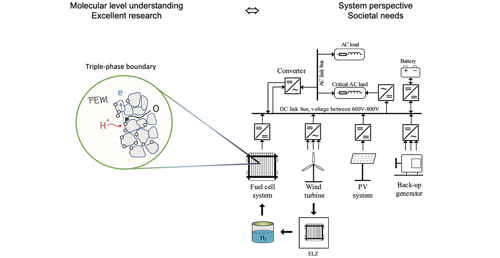Towards a more efficient use of PEM fuel cells and electrolysers

Experimental methods to investigate aging and charge transport mechanisms
PEM is the abbreviation for proton exchange membrane, a crucial component at the heart of PEM fuel cells and PEM electrolysers. This type of devices convert chemical energy in electricity (fuel cells) and vice versa (electrolysers), using hydrogen as an energy vector. PEM devices are currently extremely relevant for the transition into a sustainable energy system with decarbonization as a central aim.
PEM fuel cells and PEM electrolysers are at focus in this project for being mature technologies ready for a larger scale implementation. These PEM devices are based on similar components, making results and breakthroughs of this project of mutual interest and of double value. The aim is to develop advanced experimental methods that can support us in understanding performance at the molecular level as well as degradation mechanisms. The results will guide the design of materials and components, with focus on the triple phase boundary, to enable highest efficiency and durability. The triple phase boundary consists in the contact point of the gas phase (hydrogen or oxygen gas, i.e. the reactants), the solid phase (the catalyst, on which the electrochemical reaction takes place) and the liquid phase (the electrolyte, responsible for the transport of protons), which must all cooperate for an efficient operation of the device. Accessing these sites is an extremely challenging task, which require innovative thinking as well as breaking down the bigger problem into smaller sub-projects. Electron microscopy (primarily SEM), vibrational spectroscopy (Raman spectroscopy) and electrochemistry are currently at focus, while in-situ fuel cell tests will also be performed at a later stage of the project. The project has the potential to contribute to the System layer, by providing relevant data for the design of a suitable grid / PEM device interface, with particular focus on operational conditions. Also, the needed interface between PEM devices and other energy storage devices like batteries and supercapacitors, makes obvious connections within the layer Materials and Devices for Energy Storage.
Involved in the project
Dylan Schulz (PhD student), Anna Martinelli (supervisor) and Anders Palmqvist (co-supervisor).
Partners
Chalmers University of Technology, Västra Götalandsregionen, Smoltek, Celcibus, Hymeth, Ionautics, Hydri Solutions, Hitachi Energy, Svenska kraftnät, Nanoscientifica, Swedish Energy Agency